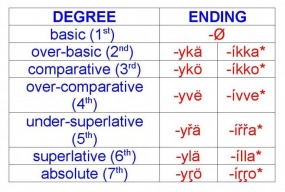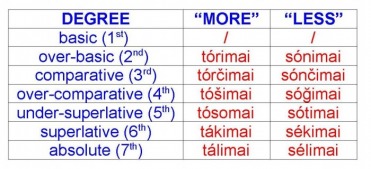> Grammar > 3. Adjectives
3. Adjectives
3.1. Characteristics
3.2. Types of adjectives
3.3. Declensions of adjectives
3.4. Adjectival comparison
Only qualitative adjectives can be compared. There are three ways of adjectival comparison – seven-degree comparison with endings, seven-degree comparison with adverbs and two-degree comparison.
3.4.1. Seven-degree comparison with endings
Instead of adjectival ending the comparison ending is used.
Compared adjectives have only “basic” cases. Instead of vocative and equative the nominative is used, instead of partitive the genitive is used.
Below are showed the endings:
The second ending (*) is used, when:
> the vowel before the ending in stressed and changes into -í-
> the first letter of a word is stressed vowel and fore the comparative ending is also vowel, the roof extends with -t-
The compared adjectives have different declined endings than normal adjectives:
3.4.2. Seven-degree comparison with adverbs
Before the adjective, the adverb is placed. Adjective is in its “normal” form.
The adverbs are:
3.4.3. Two-degree comparison
Here are only two degrees: basic and non-basic. The non-basic degree is expressed with prefix.
There are many different prefixes:
> ter-
> mal-
> eni-
> lie-
> ro-
> am-
Unfortunately, there's no rule when is some prefix used, except for the rule that the prefixes, ending in a vowel, are used with the adjectives beginning in a consonant; and the other way around is the same.
However, there's also a non-basic degree with adverb (l)eíre. This degree is kind of “higher” than the normal non-basic degree.
Example: ipráymï (beautiful) → malipráymï (so beautiful); (l)eíre malipráymï – “really” so beautiful/absolutely beautiful



